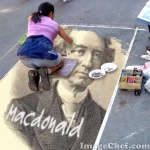 Pierre Trudeau always had a way of grabbing headlines. As the Unconventional Prime Minister, he attracted attention from the start of his political career, capturing his first Newsmaker of the Year nod in 1968, the year he became PM. He went on to win the designation 10 more times, being chosen an impressive eight years in row from 1968 to 1975, then again three years later. In 1999, he was picked again — as well as crowned Canadian Newsmaker of the Century. Trudeau received the title one last time in 2000, the year he died.
Pierre Trudeau always had a way of grabbing headlines. As the Unconventional Prime Minister, he attracted attention from the start of his political career, capturing his first Newsmaker of the Year nod in 1968, the year he became PM. He went on to win the designation 10 more times, being chosen an impressive eight years in row from 1968 to 1975, then again three years later. In 1999, he was picked again — as well as crowned Canadian Newsmaker of the Century. Trudeau received the title one last time in 2000, the year he died.
The PM with the second most Newsmaker titles is Lester Pearson, clocking in with nine wins. Interestingly, he received six of those while serving as a foreign affairs diplomat or minister, and just three as leader. Other PMs to be CP’s Newsmaker of the Year have been John Diefenbaker (5 times), Brian Mulroney (3), Jean Chrétien (2), Paul Martin (2), Stephen Harper (2), William Lyon Mackenzie King (1), Louis St. Laurent (1), Joe Clark (1), Kim Campbell (1) and Justin Trudeau (1).
 In 2004, three of Canada’s Prime Ministers made the 50 Most Important Leaders in History listed in the annual National Geographic Almanac of World History. Quite an achievement in a list that starts with the mythological first Chinese Emperor Fuxi (anywhere from 29,000 BCE to 12,000 BCE) and ends with South Africa’s Nelson Mandella.
In 2004, three of Canada’s Prime Ministers made the 50 Most Important Leaders in History listed in the annual National Geographic Almanac of World History. Quite an achievement in a list that starts with the mythological first Chinese Emperor Fuxi (anywhere from 29,000 BCE to 12,000 BCE) and ends with South Africa’s Nelson Mandella. Six Prime Ministers did not use their first given names. They were Henry (Wilfrid) Laurier, Joseph (Pierre) Trudeau, Charles (Joe) Clark, Martin (Brian) Mulroney, Avril (Kim) Clark and Joseph (Jean) Chrétien.
Six Prime Ministers did not use their first given names. They were Henry (Wilfrid) Laurier, Joseph (Pierre) Trudeau, Charles (Joe) Clark, Martin (Brian) Mulroney, Avril (Kim) Clark and Joseph (Jean) Chrétien.



